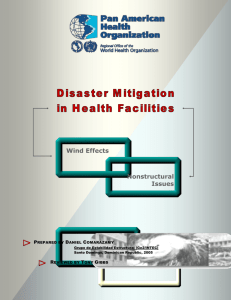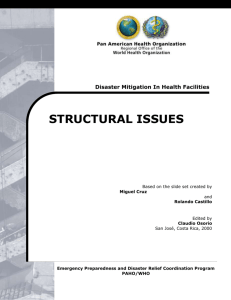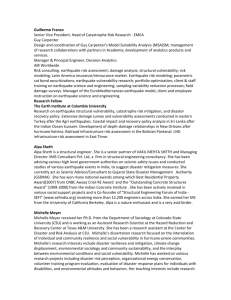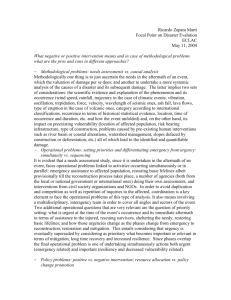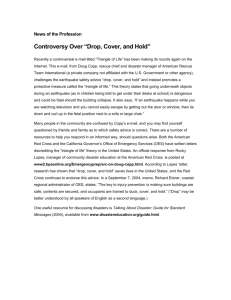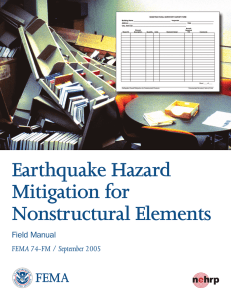Disaster Mitigation In Health Facilities
advertisement
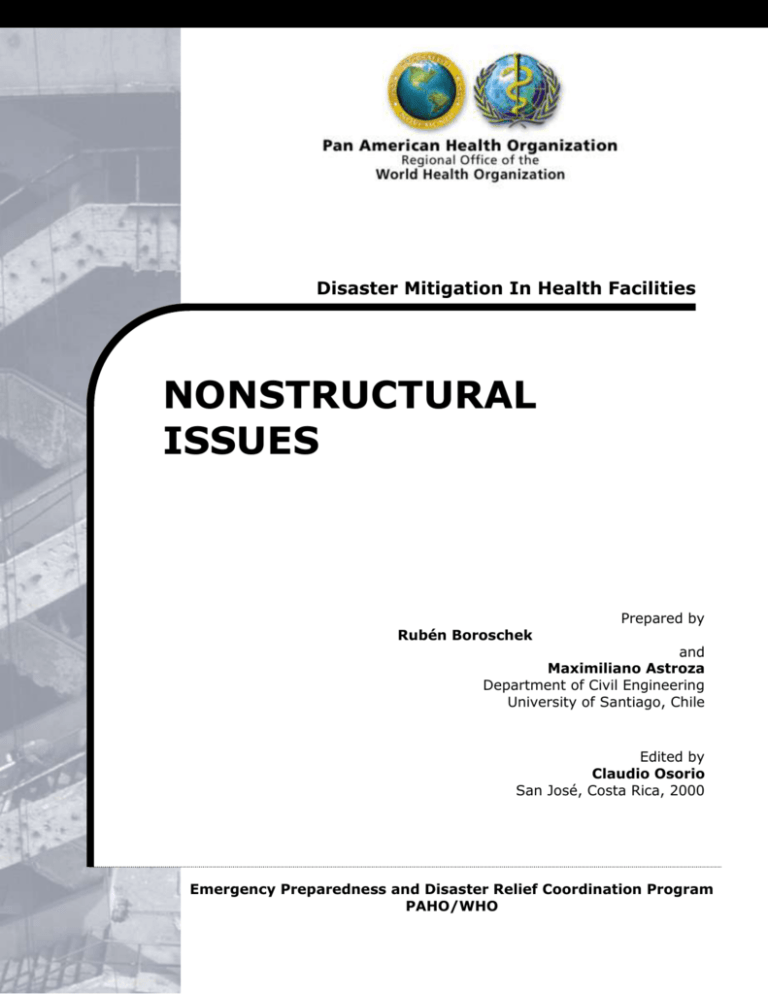
Disaster Mitigation In Health Facilities NONSTRUCTURAL ISSUES Rubén Boroschek Prepared by and Maximiliano Astroza Department of Civil Engineering University of Santiago, Chile Edited by Claudio Osorio San José, Costa Rica, 2000 Emergency Preparedness and Disaster Relief Coordination Program PAHO/WHO Pan American Health Organization, 2000 A publication of the Emergency Preparedness and Disaster Relief Coordination Program, PAHO/WHO. The views expressed, the recommendations formulated, and the designations employed in this publication do not necessarily reflect the current policies or opinions of the Pan American Health Organization or of its Member States The Pan American Health Organization welcomes requests for permission to reproduce or translate, in part or in full, this publication. Applications and inquiries should be addressed to the Emergency Preparedness and Disaster Relief Coordination Program, Pan American Health Organization, 525 Twenty-third Street, N.W., Washington, D.C. 20037, USA; fax: (202) 775-4578; e-mail: disaster-publications@paho.org. The production of this publication has been made possible through the financial support of the Swedish International Development Cooperation Agency (SIDA); Department for International Development of the U.K. (DFID); International Humanitarian Assistance Division of the Canadian International Development Agency (IHA/CIDA); and the Office of U.S. Foreign Disaster Assistance of the U.S Agency for International Development (AID/BHR/OFDA) PAHO/WHO – Disaster Mitigation in Health Facilities: Nonstructural Issues Page 2 PREFACE This script and set of attached slides were designed for health sector administrators, technicians, physicians, and users of health facilities. The goal is to provide basic information about the identification, assessment, and mitigation of nonstructural seismic hazards. Even non-specialists may carry out elementary vulnerability assessments and mitigation measures, but some tasks require the participation and supervision of specialists. Nevertheless, the risk reduction levels achieved by even the simplest mitigation measures are crucial if a hospital is to continue functioning after a major earthquake when it is most vulnerable and most needed. This document focuses exclusively on seismic disasters, given the frequency and destructive power of such phenomena in the Americas. INTRODUCTION All too frequently in Latin America and the Caribbean, earthquakes have damaged hospitals and other essential buildings, in some cases even causing their collapse. One of the lessons we have learned is that the ability of health facilities to continue functioning after such an event is not determined solely by the steps that have been taken to lower structural vulnerability to earthquakes. It is important to view health facilities as an integrated whole, made up of structural and nonstructural components, as well as the organizational and administrative procedures that enable the hospital or health center to carry out its vital mission. A health facility's clinical and support services depend on both human and physical components and it is important to determine the risks they face and how to mitigate them. A diagram showing the activities of a hospital in the aftermath of an earthquake (slide 2) presents the institution as an integrated set of services with special characteristics, both organizational and material—all of which can be affected in the event of a disaster. In order to guarantee the smooth operation of a hospital, efforts must be made to reduce both physical and organizational vulnerability. When assessing vulnerability to hazards, the physical aspects of a hospital can be classified into structural and nonstructural components. The structural components are those that enable the building to remain standing. They include the foundations, structural walls, beams and girders, and columns. Nonstructural components, on the other hand, are those architectural elements (slide 3) that are supported by the structural components, including partition walls, windows and ceilings; electrical and mechanical installations such as the communications network; gas, water, and heating systems; and furnishings found within the building, such as medical equipment or supplies. It should be noted that nonstructural components are not limited to those located within the structure, but include items located outside of the building, such as an exterior water storage tank. Of course, structural components are essential to health facilities: their partial or total collapse can prevent the institution from carrying out its mission, and cause death or injury to patients and medical staff. In a hospital, as in other buildings, structural and nonstructural components interact in complex and not always obvious ways. For example, an architectural façade can substantially alter the structural behavior of the structure. The placement of heavy equipment or water storage tanks in the upper stories of a building may change the way a structure responds to seismic forces. When assessing nonstructural vulnerability, it is essential to consider the structural components, and vice versa. ASSESSMENT PROCEDURES In many cases, common sense is all that is required to detect the vulnerability of certain items and take the necessary steps needed to mitigate the impact of an earthquake. This is particularly true for furniture, filing cabinets, shelves and the objects placed on them, lamps, glass partitions, and smaller medical or support equipment. In general, the preventive measures that can be adopted in these cases are the following: 1. Remove the object; 2. Relocate the object; PAHO/WHO – Disaster Mitigation in Health Facilities: Nonstructural Issues Page 3 3. Replace the object; 4. Modify the object; 5. Restrict mobility by fastening or anchoring the object; 6. Provide adequate connections and use flexible couplers; 7. Have a replacement for the object in case it breaks. In other cases, it is better for the assessment and mitigation measures to be carried out under the supervision of qualified professionals. The nonstructural components that require such supervision include architectural components, such as façades or windows, large machinery or equipment, and equipment considered critical due to its function, the degree to which it may be hazardous in an emergency situation, or its cost (for example, scanners or emergency power generators). Nonstructural vulnerability assessments must evaluate different and complex aspects that are closely interrelated. It is useful to group similar components, so that a common methodology may be applied. Nonstructural components are divided into three large groups: architectural components, equipment, and basic installations. The architectural components that are commonly found in hospitals and that must be protected are mentioned in table 1 (slide 4). When assessing nonstructural vulnerability, qualitative and quantitative analyses must be carried out to evaluate the components’ safety, their potential impact on the operations of the hospital, and the vulnerability of the hospital as a whole. Such an assessment must take into account the direct effect of an earthquake on the nonstructural components (accelerations and displacements), as well as the effects of the interaction of the structure and other nonstructural components. Table 1. Nonstructural components to be considered in vulnerability assessment ARCHITECTURAL COMPONENTS EQUIPMENT BASIC INSTALLATIONS Interior partitions Medical equipment Medical gas piping Façades Laboratory equipment Industrial gas piping Suspended ceilings Industrial equipment Vacuum devices Roofs or decks Office equipment Steam Parapets Furniture Air-conditioning system Chimneys Supplies Heating Plaster Ventilation Glass windows Electrical wiring Attachments (signs and antennae) Backup power Ornaments Communications Canopies Drinking water Lighting system Industrial water Railings Sewerage Doors and exit routes Fire sprinklers Expansion joints Other pipelines Circulation (elevators, stairs) PAHO/WHO – Disaster Mitigation in Health Facilities: Nonstructural Issues Page 4 The procedures used to assess nonstructural vulnerability include the following (slide 5): 1. Previous experiences. Hazard assessment is carried out on the basis of experiences with similar components in previous seismic events. In these cases, it is essential to evaluate the structural response and performance of a particular element in a previous earthquake. For example, in evaluating certain equipment one must know its location in a building. The same object may respond very well on a lower floor of a building but not on a higher floor because of differences in the way a structure responds. 2. Mathematical analysis. To apply this procedure, mathematical models must be developed to consider the piece of equipment, its parts, the way it is supported, and its connections with the supporting structure. Information is needed on the physical characteristics of the element (mass distribution, rigidity, energy dissipation capacity, internal connections and parts, etc.). 3. Laboratory tests. When the components are complex and their physical properties not well known, or mathematical models are not very effective, simple laboratory tests can be devised to estimate the likelihood of the objects tipping over or sliding. More complex tests involve the use of shaking tables or loading frames. 4. Team of experts. A team of experts should carry out the procedures outlined above. When economic or physical limitations do not allow these procedures to be carried out, the expertise and knowledge of a group of experts may be the only realistic way to assess the level of hazard. ARCHITECTURAL COMPONENTS Architectural components, such as façades, lighting fixtures, and partition walls must be assessed in terms of the functional and physical consequences of their failure. The typical causes of failure are related to joints, separation from other components, the fragility of the object itself and, of course, the demands placed on the component depending on where it is located within the structure. The failure of these components can be of three kinds: impact damage (slide 6), falling (slides 7 and 8), or changes in the response of structural and nonstructural components. The procedures to assess the risk to these components are a function of the likely deformations and inertia to which the architectural components will be subjected, and their capacity to withstand these forces. Components such as façades and interior partitions that are used to close off an area can cause serious damage to the orderly flow of health services. This is a particular hazard when non-tempered glass or other fragile materials are used, especially in areas that require special protection such as the neonatal ward or the intensive care and burn units (slide 9). Some measures to protect architectural components are listed in slide 10: 1. Isolate the component so that it will not be affected by structural deformation; 2. Select components that are capable of withstanding the deformations imposed by the structure (components that are anchored to the structure); 3. Provide lateral supports and anchors to stabilize the element. Plaster and other coverings must be carefully assessed and removed if found to be vulnerable (slide 11). Cantilevered components such as walls (slide 12), antennae, or signs (slide 13) must be correctly supported (slide 14). Ceilings must be properly braced (slides 15 and 16) and the components supported by them, such as lighting, air ducts, and so on, must be isolated and anchored independently. Special attention should be given to detailing where there are expansion or seismic joints (slides 17 and 18). For instance, it is necessary to use butt-joints, and to pay attention to the detailing of the intersection of duct joints, ceilings, roofs, partition walls, and the like. PAHO/WHO – Disaster Mitigation in Health Facilities: Nonstructural Issues Page 5 EQUIPMENT Medical, laboratory, and support equipment is essential to a hospital. However, during an earthquake, such equipment may pose hazards to people and to the functioning of the system. The following are examples of possible dangers: 1. Impact of sharp objects; 2. Impact of objects that fall from a considerable height; 3. Impact of objects that slide or roll on the floor; 4. Direct contact with pollutants or toxic substances; 5. Disconnection of, or damage to, essential life-support systems; 6. Contact with exposed electric cables, broken steam or gas pipelines; 7. Inability to replace essential equipment or supplies; 8. People trapped; 9. Equipment failure; 10. Economic damage or loss. For effective mitigation, it is useful to first classify the equipment depending on how essential it is in the event of an earthquake, and how dangerous it may be to the building’s occupants or other equipment (slide 19). Generally, equipment and furniture are built and installed considering only their normal, everyday use. It is common to find components that lack any means of support or anchoring. This increases the risk of objects tipping over (slides 20, 21 and 22) or sliding during an earthquake (slides 23, 24 and 25). In the case of large equipment, special consideration should be given to restraint devices. Flexible couplings should be used to accommodate the displacement of the equipment. To reduce damage to the equipment, anchoring and other devices must be used to control sliding and tipping and to guarantee stability, and these devices must be compatible with the operating conditions of the equipment. They can include the following: anchor bolts, stoppers, hooks or plates to prevent tilting, cut-off valves, flexible joints, and lateral braces, among others. (slides 26, 27, 28, 29 and 30) In order to reduce the losses and hazards associated with supplies and containers (slides 31, 32 and 33), devices such as grates, bars, or perforated bases (slides 34 and 35) should be in place to limit displacement and tilting. These mooring and fastening devices must be compatible with the use of the equipment or supplies. Unsecured objects must not be placed over the beds of patients, or in access and evacuation routes. Shelves must be attached to the walls and well supported, and hazardous supplies kept in places where they cannot fall or be impacted by other objects. Measures must be taken to ensure that materials, pharmaceuticals, reagents, and other chemical products do not fall from shelves. Equipment stands with wheels should be secured when not in use. The brakes on mobile equipment and furniture should be fastened and portable equipment secured to shelves. Doors to shelves and other storage areas must have locks so that they do not fly open when hit by their contents. Shelves or tabletops where portable equipment is kept must have raised edges to prevent objects from sliding and falling over. BASIC INSTALLATIONS Hospitals have a large number of pipes, ducts and cables forming part of the systems that provide air conditioning and heating, cold and hot water, steam, industrial and clinical gases, electricity, and liquid and solid waste disposal. All these components are distributed spatially in different ways, sometimes encased in the seismic-resistant structure, attached externally to it or hidden by architectural components such as partition walls or shafts (slide 36). Damage to these components typically is caused by direct vibration or deformations between the support and coupling points, or by damage to the structural and nonstructural components that support them. Because of their spatial characteristics, assessing these installations must be done from the point of generation (or entry into the institutional network from a public utility) to all the points of use, taking into account aspects such as PAHO/WHO – Disaster Mitigation in Health Facilities: Nonstructural Issues Page 6 the safety of the generation and backup points, of the network layout (stability of the supports), and of the supply points (slide 37). To prevent damage to these nonstructural components, attention must be paid to the support, bracing and reinforcement of the couplings and joints (slide 38), and to the detailing of the crossings through expansion joints (slide 39). Flexible joints are recommended for any crossings, and furthermore, it is preferable to cross expansion or seismic joints in the lower stories of a building (slide 40). The supports and bracing must be properly detailed and spaced to prevent excessive motion during an earthquake (slide 41), and the pipes and ducts must be located in safe structural and nonstructural components. SOURCES FOR SLIDES: FEMA 74, Reducing the Risks of Nonstructural Earthquake Damage: A Practical Guide, Federal Emergency Management Agency, Third Edition, September 1994, USA Ministry of Health, Chile EERC Library PAHO/WHO Library Rubén Boroschek Maximiliano Astroza Omar Darío Cardona José Grases PAHO/WHO – Disaster Mitigation in Health Facilities: Nonstructural Issues Page 7

